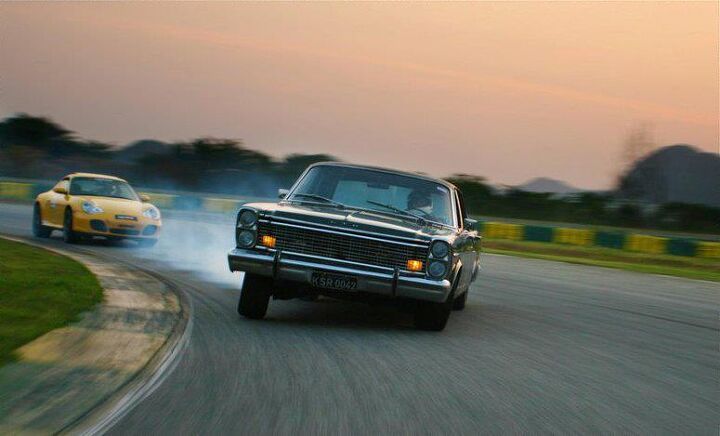Piston Slap: What Makes a Bad Suspension?

TTAC commentator Seminole95 writes:
Sajeev,
The Wall Street Journal recently suggested that part of VW’s problem in the US is the slow growth in Passat sales. About the Passat sales, they attribute it to a cheapening of the components relative to the European Passat, stating: “The American model also got a simpler, lower-cost suspension that delivered a less precise ride.”
My question is: how does one tell a priori that they are buying a car with a cheap suspension? Many mainstream media car reviews do not discuss the objective quality and construction of suspension components, preferring to discuss subjective feelings of ride. In addition, a car’s ride may “feel” good now, but this does not mean that it will in 5 years.
As an aside, one of the reasons I am interested is, I am thinking about buying the new Honda Accord and trading in my old one. But the new Accords have the MacPherson struts whereas the old ones had a double wishbone setup.
Thank you, TTAC, and your readers for intelligent car discussion.
Sajeev answers:
Ya know, autojournalism is a tough gig: explain why you feel a certain way and you bore people with engineering jargon. Well, that’s provided you actually have to chops to explain why a certain design/component behaves a certain way in the first place! But I digress…let’s begin with some salient points:
- Some suspension designs are better than others, depending on application. Sports cars shouldn’t have leaf springs (please accept my apology, Morgan) but I seriously doubt I’d ever want a truck without them (sorry RAM).
- The quality of suspension components makes all the difference in the world. To wit, upgrading shocks (Konis, Bilsteins, etc.) on a seemingly terrible suspension can, by magic, make it the best in its class.
- Mainstream Auto Journalism or no, opinions on this subject are mostly subjective…if not entirely subjective!
Shall you feel a big difference between a new Honda Accord and the older models with double wishbones? Possibly, but that could be attributed to a host of suspension and chassis changes, not the original design. Don’t believe me? Just look at what BMW’s done in terms of suspension feel utilizing this same McPherson strut template.
Now about the Passat: the 2014 model (at least) has a fully independent suspension on all trim levels. Even the base model Jetta, according to the website, regained complete independence from solid axles. But let’s say you like the Toyota Corolla or Ford Mustang: is your ass critically fine tuned enough and do you even care on those rare occasions when a modern solid axle vehicle feels juuuust a little wonky on a curvy+bumpy road?
We all aren’t a Jack Baruth on track…and hell, even Jack Baruth drives a Lincoln Town Car with a watt’s link solid axle on the street, son!
So this is much ado about nothing! My bigger concern is the quality/configuration/durability of the suspension components, not their basic design. Sloppy tuned shocks, poorly sized sway bars, defective ball joints, etc. are a bigger concern. And none of that can be addressed at the time of purchase, sadly.
Send your queries to sajeev@thetruthaboutcars.com. Spare no details and ask for a speedy resolution if you’re in a hurry…but be realistic, and use your make/model specific forums instead of TTAC for more timely advice.

More by Sajeev Mehta
Latest Car Reviews
Read moreLatest Product Reviews
Read moreRecent Comments
- Plaincraig 1975 Mercury Cougar with the 460 four barrel. My dad bought it new and removed all the pollution control stuff and did a lot of upgrades to the engine (450hp). I got to use it from 1986 to 1991 when I got my Eclipse GSX. The payments and insurance for a 3000GT were going to be too much. No tickets no accidents so far in my many years and miles.My sister learned on a 76 LTD with the 350 two barrel then a Ford Escort but she has tickets (speeding but she has contacts so they get dismissed or fine and no points) and accidents (none her fault)
- Namesakeone If I were the parent of a teenage daughter, I would want her in an H1 Hummer. It would be big enough to protect her in a crash, too big for her to afford the fuel (and thus keep her home), big enough to intimidate her in a parallel-parking situation (and thus keep her home), and the transmission tunnel would prevent backseat sex.If I were the parent of a teenage son, I would want him to have, for his first wheeled transportation...a ride-on lawnmower. For obvious reasons.
- ToolGuy If I were a teen under the tutelage of one of the B&B, I think it would make perfect sense to jump straight into one of those "forever cars"... see then I could drive it forever and not have to worry about ever replacing it. This plan seems flawless, doesn't it?
- Rover Sig A short cab pickup truck, F150 or C/K-1500 or Ram, preferably a 6 cyl. These have no room for more than one or two passengers (USAA stats show biggest factor in teenage accidents is a vehicle full of kids) and no back seat (common sense tells you what back seats are used for). In a full-size pickup truck, the inevitable teenage accident is more survivable. Second choice would be an old full-size car, but these have all but disappeared from the used car lots. The "cute small car" is a death trap.
- W Conrad Sure every technology has some environmental impact, but those stuck in fossil fuel land are just not seeing the future of EV's makes sense. Rather than making EV's even better, these automakers are sticking with what they know. It will mean their end.


































Comments
Join the conversation
Different strokes for different folks. Just make sure your test drives are thorough and you'll weed out the stuff you don't like.
How do we determine quantitatively, what a bad suspension is? Everyone can always have an opinion, but numbers would let us know if our impressions are right, and to what degree. We certainly have two major ways to measure horizontal cornering performance: skid-pad and slalom. But what about "vertical performance", which we commonly call ride quality? How to measure that? Well, if some sort of accelerometer (like a seismometer for earthquakes) where attached to the following places on a car, it would do just that: 1) The lower suspension arm, where it is attached to the wheel; 2) The floor on the passenger's side (or a side panel on the car); 3) The passenger's seat itself, on the cushion. It should not take too much guessing to see that the first tells you what the suspension has to deal with; the second tells you what the car has to deal with; and the third tells you what the human has to deal with. Some of the motion-vs.-time traces, their maxima, and their slopes, could be quantified for measurements in all three cases. But what about standard test roads specific for this ride quality? I could suggest three things: 1) A straight smooth concrete road with 1/2-inch high by 1-inch wide metal bars going straight across it, separated by 20 feet. There could be 10 such bars. These would simulate severe expansion joint or tar-strip conditions on real roads; 2) A straight smooth concrete road with 2-inch deep by 1-foot long metal trenches or troughs embedded into the concrete, running half-way across the road, but then staggered with another trench coming from the other side. Each half-trench could be separated by 20 feet. This would be meant to measure, not surprisingly, pot holes (mild ones at that!). 3) An undulating straight road surface with sinusoidal "waves" that are perhaps 3 inches high and have a wavelength of 10 feet. 10 such cycles could be molded as concrete into the concrete road. These would measure the ability of the vehicle to handle larger scale, uneven road surfaces; Perhaps the testing could be done for: 1) City speeds, say about 30 mph; 2) Back-road highway speeds, say about 60 mph. Anyone have any feelings on this idea? --------------------